Organisational Culture and Physical Space: A Critical Analysis
VerifiedAdded on 2021/06/10
|11
|4812
|435
Essay
AI Summary
This essay critically examines the significance of physical space in maintaining organizational culture. It begins by highlighting the correlation between office design and organizational culture, emphasizing how physical environments communicate values and impact working practices. The literature review explores the relationship between office space and organizational culture, discussing how office layouts can reflect power dynamics, role orientation, achievement, and support. The essay then discusses the impact of changing office spaces on organizational culture, emphasizing the importance of physical and social interactions. It also discusses how virtual work environments can weaken organizational culture and how organizations try to mitigate the lack of face-to-face interactions. The essay further discusses the limitations of solely relying on physical space for cultural representation and concludes that while physical spaces have traditionally been crucial for maintaining organizational culture, hybrid cultures are quickly developing with advancements in technology.
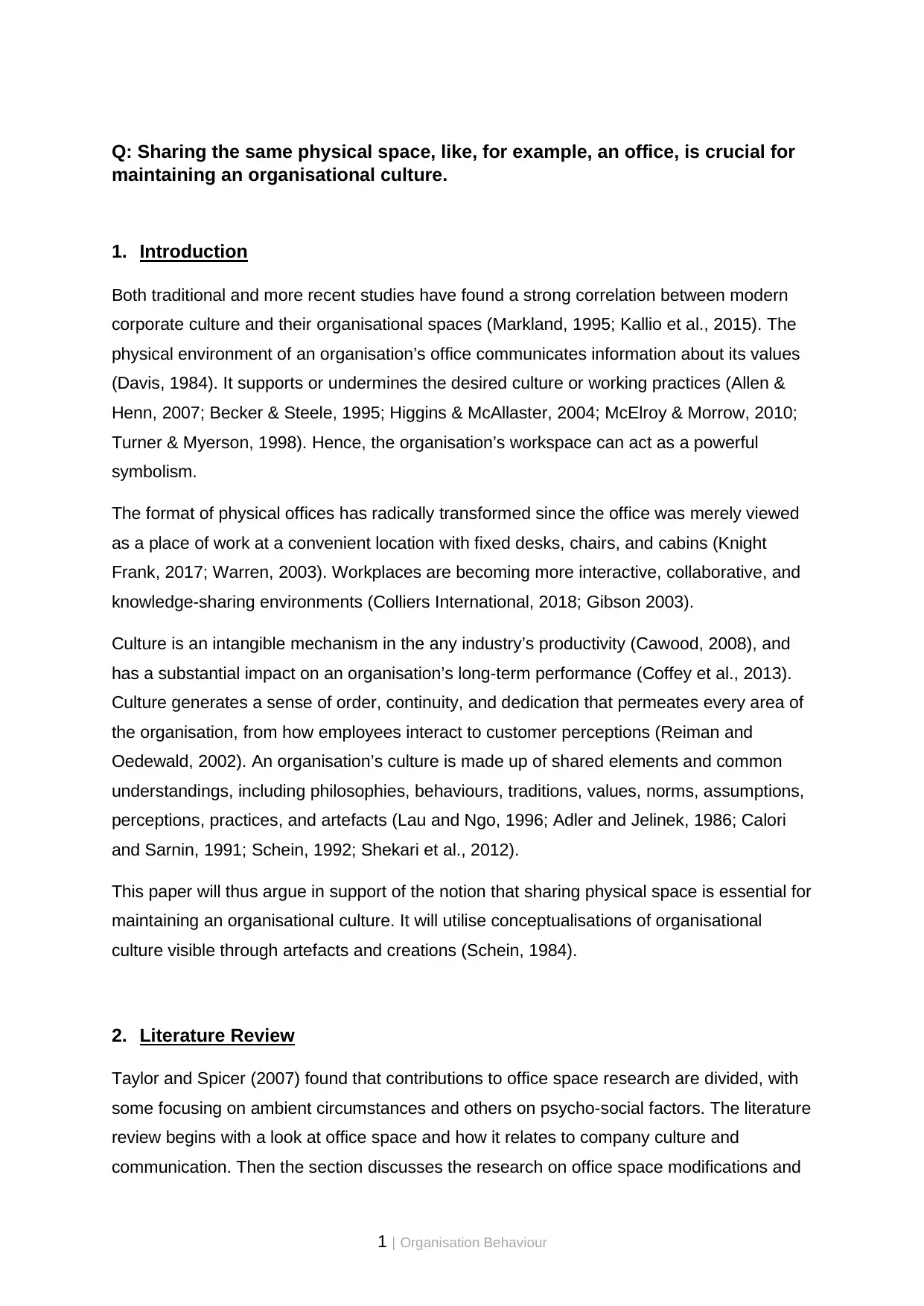
1 | Organisation Behaviour
Q: Sharing the same physical space, like, for example, an office, is crucial for
maintaining an organisational culture.
1. Introduction
Both traditional and more recent studies have found a strong correlation between modern
corporate culture and their organisational spaces (Markland, 1995; Kallio et al., 2015). The
physical environment of an organisation’s office communicates information about its values
(Davis, 1984). It supports or undermines the desired culture or working practices (Allen &
Henn, 2007; Becker & Steele, 1995; Higgins & McAllaster, 2004; McElroy & Morrow, 2010;
Turner & Myerson, 1998). Hence, the organisation’s workspace can act as a powerful
symbolism.
The format of physical offices has radically transformed since the office was merely viewed
as a place of work at a convenient location with fixed desks, chairs, and cabins (Knight
Frank, 2017; Warren, 2003). Workplaces are becoming more interactive, collaborative, and
knowledge-sharing environments (Colliers International, 2018; Gibson 2003).
Culture is an intangible mechanism in the any industry’s productivity (Cawood, 2008), and
has a substantial impact on an organisation’s long-term performance (Coffey et al., 2013).
Culture generates a sense of order, continuity, and dedication that permeates every area of
the organisation, from how employees interact to customer perceptions (Reiman and
Oedewald, 2002). An organisation’s culture is made up of shared elements and common
understandings, including philosophies, behaviours, traditions, values, norms, assumptions,
perceptions, practices, and artefacts (Lau and Ngo, 1996; Adler and Jelinek, 1986; Calori
and Sarnin, 1991; Schein, 1992; Shekari et al., 2012).
This paper will thus argue in support of the notion that sharing physical space is essential for
maintaining an organisational culture. It will utilise conceptualisations of organisational
culture visible through artefacts and creations (Schein, 1984).
2. Literature Review
Taylor and Spicer (2007) found that contributions to office space research are divided, with
some focusing on ambient circumstances and others on psycho-social factors. The literature
review begins with a look at office space and how it relates to company culture and
communication. Then the section discusses the research on office space modifications and
Q: Sharing the same physical space, like, for example, an office, is crucial for
maintaining an organisational culture.
1. Introduction
Both traditional and more recent studies have found a strong correlation between modern
corporate culture and their organisational spaces (Markland, 1995; Kallio et al., 2015). The
physical environment of an organisation’s office communicates information about its values
(Davis, 1984). It supports or undermines the desired culture or working practices (Allen &
Henn, 2007; Becker & Steele, 1995; Higgins & McAllaster, 2004; McElroy & Morrow, 2010;
Turner & Myerson, 1998). Hence, the organisation’s workspace can act as a powerful
symbolism.
The format of physical offices has radically transformed since the office was merely viewed
as a place of work at a convenient location with fixed desks, chairs, and cabins (Knight
Frank, 2017; Warren, 2003). Workplaces are becoming more interactive, collaborative, and
knowledge-sharing environments (Colliers International, 2018; Gibson 2003).
Culture is an intangible mechanism in the any industry’s productivity (Cawood, 2008), and
has a substantial impact on an organisation’s long-term performance (Coffey et al., 2013).
Culture generates a sense of order, continuity, and dedication that permeates every area of
the organisation, from how employees interact to customer perceptions (Reiman and
Oedewald, 2002). An organisation’s culture is made up of shared elements and common
understandings, including philosophies, behaviours, traditions, values, norms, assumptions,
perceptions, practices, and artefacts (Lau and Ngo, 1996; Adler and Jelinek, 1986; Calori
and Sarnin, 1991; Schein, 1992; Shekari et al., 2012).
This paper will thus argue in support of the notion that sharing physical space is essential for
maintaining an organisational culture. It will utilise conceptualisations of organisational
culture visible through artefacts and creations (Schein, 1984).
2. Literature Review
Taylor and Spicer (2007) found that contributions to office space research are divided, with
some focusing on ambient circumstances and others on psycho-social factors. The literature
review begins with a look at office space and how it relates to company culture and
communication. Then the section discusses the research on office space modifications and
Paraphrase This Document
Need a fresh take? Get an instant paraphrase of this document with our AI Paraphraser
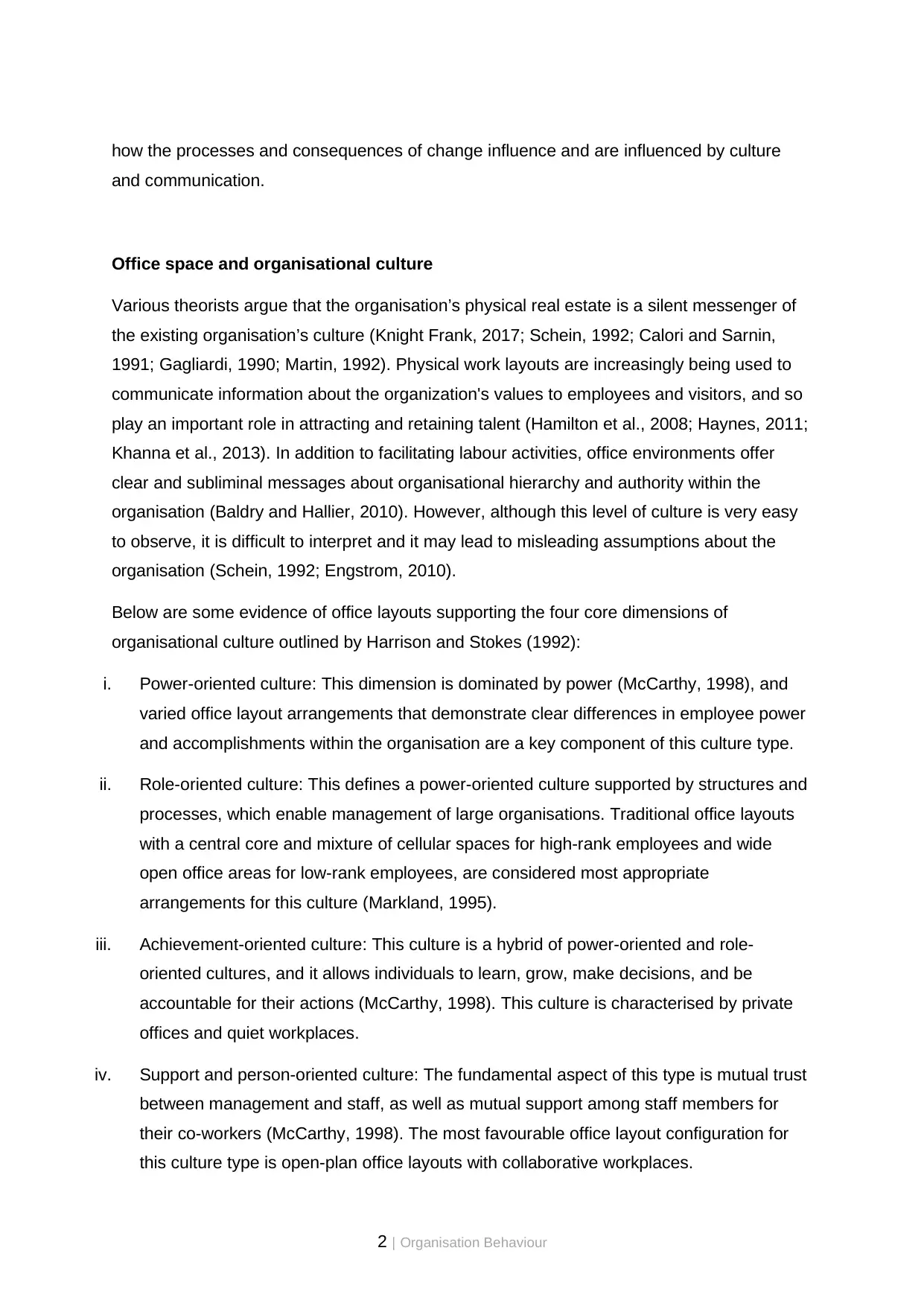
2 | Organisation Behaviour
how the processes and consequences of change influence and are influenced by culture
and communication.
Office space and organisational culture
Various theorists argue that the organisation’s physical real estate is a silent messenger of
the existing organisation’s culture (Knight Frank, 2017; Schein, 1992; Calori and Sarnin,
1991; Gagliardi, 1990; Martin, 1992). Physical work layouts are increasingly being used to
communicate information about the organization's values to employees and visitors, and so
play an important role in attracting and retaining talent (Hamilton et al., 2008; Haynes, 2011;
Khanna et al., 2013). In addition to facilitating labour activities, office environments offer
clear and subliminal messages about organisational hierarchy and authority within the
organisation (Baldry and Hallier, 2010). However, although this level of culture is very easy
to observe, it is difficult to interpret and it may lead to misleading assumptions about the
organisation (Schein, 1992; Engstrom, 2010).
Below are some evidence of office layouts supporting the four core dimensions of
organisational culture outlined by Harrison and Stokes (1992):
i. Power-oriented culture: This dimension is dominated by power (McCarthy, 1998), and
varied office layout arrangements that demonstrate clear differences in employee power
and accomplishments within the organisation are a key component of this culture type.
ii. Role-oriented culture: This defines a power-oriented culture supported by structures and
processes, which enable management of large organisations. Traditional office layouts
with a central core and mixture of cellular spaces for high-rank employees and wide
open office areas for low-rank employees, are considered most appropriate
arrangements for this culture (Markland, 1995).
iii. Achievement-oriented culture: This culture is a hybrid of power-oriented and role-
oriented cultures, and it allows individuals to learn, grow, make decisions, and be
accountable for their actions (McCarthy, 1998). This culture is characterised by private
offices and quiet workplaces.
iv. Support and person-oriented culture: The fundamental aspect of this type is mutual trust
between management and staff, as well as mutual support among staff members for
their co-workers (McCarthy, 1998). The most favourable office layout configuration for
this culture type is open-plan office layouts with collaborative workplaces.
how the processes and consequences of change influence and are influenced by culture
and communication.
Office space and organisational culture
Various theorists argue that the organisation’s physical real estate is a silent messenger of
the existing organisation’s culture (Knight Frank, 2017; Schein, 1992; Calori and Sarnin,
1991; Gagliardi, 1990; Martin, 1992). Physical work layouts are increasingly being used to
communicate information about the organization's values to employees and visitors, and so
play an important role in attracting and retaining talent (Hamilton et al., 2008; Haynes, 2011;
Khanna et al., 2013). In addition to facilitating labour activities, office environments offer
clear and subliminal messages about organisational hierarchy and authority within the
organisation (Baldry and Hallier, 2010). However, although this level of culture is very easy
to observe, it is difficult to interpret and it may lead to misleading assumptions about the
organisation (Schein, 1992; Engstrom, 2010).
Below are some evidence of office layouts supporting the four core dimensions of
organisational culture outlined by Harrison and Stokes (1992):
i. Power-oriented culture: This dimension is dominated by power (McCarthy, 1998), and
varied office layout arrangements that demonstrate clear differences in employee power
and accomplishments within the organisation are a key component of this culture type.
ii. Role-oriented culture: This defines a power-oriented culture supported by structures and
processes, which enable management of large organisations. Traditional office layouts
with a central core and mixture of cellular spaces for high-rank employees and wide
open office areas for low-rank employees, are considered most appropriate
arrangements for this culture (Markland, 1995).
iii. Achievement-oriented culture: This culture is a hybrid of power-oriented and role-
oriented cultures, and it allows individuals to learn, grow, make decisions, and be
accountable for their actions (McCarthy, 1998). This culture is characterised by private
offices and quiet workplaces.
iv. Support and person-oriented culture: The fundamental aspect of this type is mutual trust
between management and staff, as well as mutual support among staff members for
their co-workers (McCarthy, 1998). The most favourable office layout configuration for
this culture type is open-plan office layouts with collaborative workplaces.
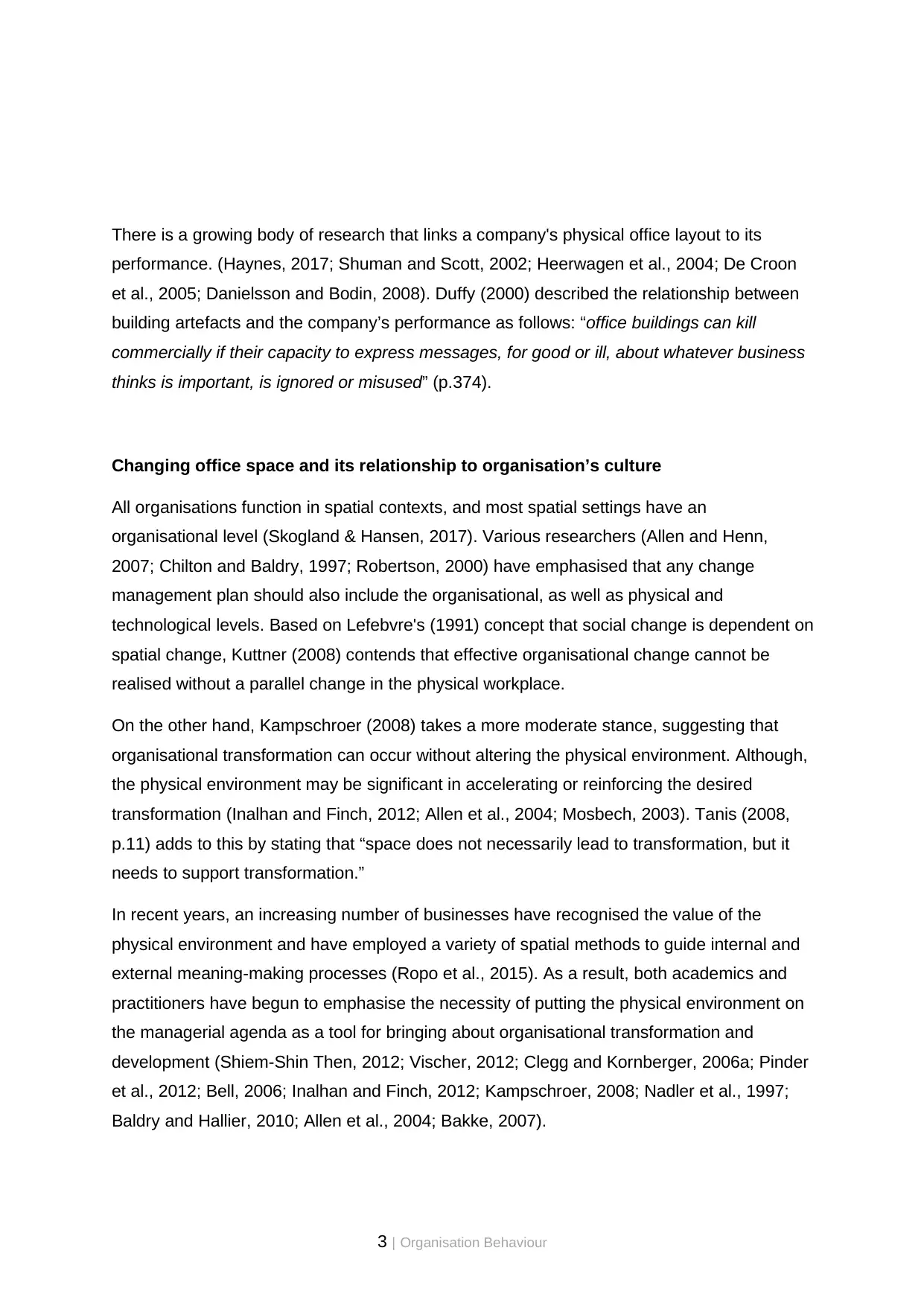
3 | Organisation Behaviour
There is a growing body of research that links a company's physical office layout to its
performance. (Haynes, 2017; Shuman and Scott, 2002; Heerwagen et al., 2004; De Croon
et al., 2005; Danielsson and Bodin, 2008). Duffy (2000) described the relationship between
building artefacts and the company’s performance as follows: “office buildings can kill
commercially if their capacity to express messages, for good or ill, about whatever business
thinks is important, is ignored or misused” (p.374).
Changing office space and its relationship to organisation’s culture
All organisations function in spatial contexts, and most spatial settings have an
organisational level (Skogland & Hansen, 2017). Various researchers (Allen and Henn,
2007; Chilton and Baldry, 1997; Robertson, 2000) have emphasised that any change
management plan should also include the organisational, as well as physical and
technological levels. Based on Lefebvre's (1991) concept that social change is dependent on
spatial change, Kuttner (2008) contends that effective organisational change cannot be
realised without a parallel change in the physical workplace.
On the other hand, Kampschroer (2008) takes a more moderate stance, suggesting that
organisational transformation can occur without altering the physical environment. Although,
the physical environment may be significant in accelerating or reinforcing the desired
transformation (Inalhan and Finch, 2012; Allen et al., 2004; Mosbech, 2003). Tanis (2008,
p.11) adds to this by stating that “space does not necessarily lead to transformation, but it
needs to support transformation.”
In recent years, an increasing number of businesses have recognised the value of the
physical environment and have employed a variety of spatial methods to guide internal and
external meaning-making processes (Ropo et al., 2015). As a result, both academics and
practitioners have begun to emphasise the necessity of putting the physical environment on
the managerial agenda as a tool for bringing about organisational transformation and
development (Shiem-Shin Then, 2012; Vischer, 2012; Clegg and Kornberger, 2006a; Pinder
et al., 2012; Bell, 2006; Inalhan and Finch, 2012; Kampschroer, 2008; Nadler et al., 1997;
Baldry and Hallier, 2010; Allen et al., 2004; Bakke, 2007).
There is a growing body of research that links a company's physical office layout to its
performance. (Haynes, 2017; Shuman and Scott, 2002; Heerwagen et al., 2004; De Croon
et al., 2005; Danielsson and Bodin, 2008). Duffy (2000) described the relationship between
building artefacts and the company’s performance as follows: “office buildings can kill
commercially if their capacity to express messages, for good or ill, about whatever business
thinks is important, is ignored or misused” (p.374).
Changing office space and its relationship to organisation’s culture
All organisations function in spatial contexts, and most spatial settings have an
organisational level (Skogland & Hansen, 2017). Various researchers (Allen and Henn,
2007; Chilton and Baldry, 1997; Robertson, 2000) have emphasised that any change
management plan should also include the organisational, as well as physical and
technological levels. Based on Lefebvre's (1991) concept that social change is dependent on
spatial change, Kuttner (2008) contends that effective organisational change cannot be
realised without a parallel change in the physical workplace.
On the other hand, Kampschroer (2008) takes a more moderate stance, suggesting that
organisational transformation can occur without altering the physical environment. Although,
the physical environment may be significant in accelerating or reinforcing the desired
transformation (Inalhan and Finch, 2012; Allen et al., 2004; Mosbech, 2003). Tanis (2008,
p.11) adds to this by stating that “space does not necessarily lead to transformation, but it
needs to support transformation.”
In recent years, an increasing number of businesses have recognised the value of the
physical environment and have employed a variety of spatial methods to guide internal and
external meaning-making processes (Ropo et al., 2015). As a result, both academics and
practitioners have begun to emphasise the necessity of putting the physical environment on
the managerial agenda as a tool for bringing about organisational transformation and
development (Shiem-Shin Then, 2012; Vischer, 2012; Clegg and Kornberger, 2006a; Pinder
et al., 2012; Bell, 2006; Inalhan and Finch, 2012; Kampschroer, 2008; Nadler et al., 1997;
Baldry and Hallier, 2010; Allen et al., 2004; Bakke, 2007).
⊘ This is a preview!⊘
Do you want full access?
Subscribe today to unlock all pages.

Trusted by 1+ million students worldwide
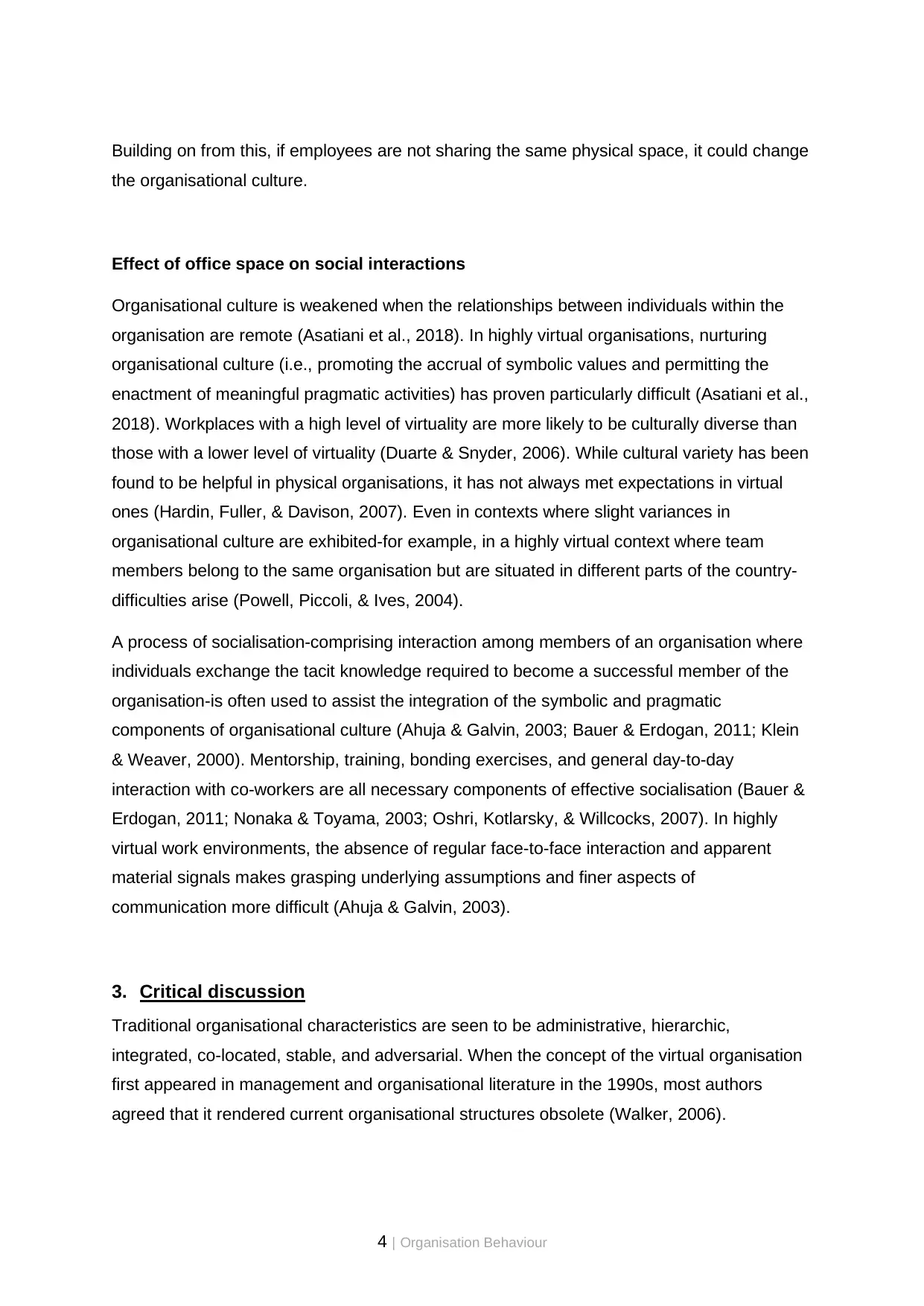
4 | Organisation Behaviour
Building on from this, if employees are not sharing the same physical space, it could change
the organisational culture.
Effect of office space on social interactions
Organisational culture is weakened when the relationships between individuals within the
organisation are remote (Asatiani et al., 2018). In highly virtual organisations, nurturing
organisational culture (i.e., promoting the accrual of symbolic values and permitting the
enactment of meaningful pragmatic activities) has proven particularly difficult (Asatiani et al.,
2018). Workplaces with a high level of virtuality are more likely to be culturally diverse than
those with a lower level of virtuality (Duarte & Snyder, 2006). While cultural variety has been
found to be helpful in physical organisations, it has not always met expectations in virtual
ones (Hardin, Fuller, & Davison, 2007). Even in contexts where slight variances in
organisational culture are exhibited-for example, in a highly virtual context where team
members belong to the same organisation but are situated in different parts of the country-
difficulties arise (Powell, Piccoli, & Ives, 2004).
A process of socialisation-comprising interaction among members of an organisation where
individuals exchange the tacit knowledge required to become a successful member of the
organisation-is often used to assist the integration of the symbolic and pragmatic
components of organisational culture (Ahuja & Galvin, 2003; Bauer & Erdogan, 2011; Klein
& Weaver, 2000). Mentorship, training, bonding exercises, and general day-to-day
interaction with co-workers are all necessary components of effective socialisation (Bauer &
Erdogan, 2011; Nonaka & Toyama, 2003; Oshri, Kotlarsky, & Willcocks, 2007). In highly
virtual work environments, the absence of regular face-to-face interaction and apparent
material signals makes grasping underlying assumptions and finer aspects of
communication more difficult (Ahuja & Galvin, 2003).
3. Critical discussion
Traditional organisational characteristics are seen to be administrative, hierarchic,
integrated, co-located, stable, and adversarial. When the concept of the virtual organisation
first appeared in management and organisational literature in the 1990s, most authors
agreed that it rendered current organisational structures obsolete (Walker, 2006).
Building on from this, if employees are not sharing the same physical space, it could change
the organisational culture.
Effect of office space on social interactions
Organisational culture is weakened when the relationships between individuals within the
organisation are remote (Asatiani et al., 2018). In highly virtual organisations, nurturing
organisational culture (i.e., promoting the accrual of symbolic values and permitting the
enactment of meaningful pragmatic activities) has proven particularly difficult (Asatiani et al.,
2018). Workplaces with a high level of virtuality are more likely to be culturally diverse than
those with a lower level of virtuality (Duarte & Snyder, 2006). While cultural variety has been
found to be helpful in physical organisations, it has not always met expectations in virtual
ones (Hardin, Fuller, & Davison, 2007). Even in contexts where slight variances in
organisational culture are exhibited-for example, in a highly virtual context where team
members belong to the same organisation but are situated in different parts of the country-
difficulties arise (Powell, Piccoli, & Ives, 2004).
A process of socialisation-comprising interaction among members of an organisation where
individuals exchange the tacit knowledge required to become a successful member of the
organisation-is often used to assist the integration of the symbolic and pragmatic
components of organisational culture (Ahuja & Galvin, 2003; Bauer & Erdogan, 2011; Klein
& Weaver, 2000). Mentorship, training, bonding exercises, and general day-to-day
interaction with co-workers are all necessary components of effective socialisation (Bauer &
Erdogan, 2011; Nonaka & Toyama, 2003; Oshri, Kotlarsky, & Willcocks, 2007). In highly
virtual work environments, the absence of regular face-to-face interaction and apparent
material signals makes grasping underlying assumptions and finer aspects of
communication more difficult (Ahuja & Galvin, 2003).
3. Critical discussion
Traditional organisational characteristics are seen to be administrative, hierarchic,
integrated, co-located, stable, and adversarial. When the concept of the virtual organisation
first appeared in management and organisational literature in the 1990s, most authors
agreed that it rendered current organisational structures obsolete (Walker, 2006).
Paraphrase This Document
Need a fresh take? Get an instant paraphrase of this document with our AI Paraphraser
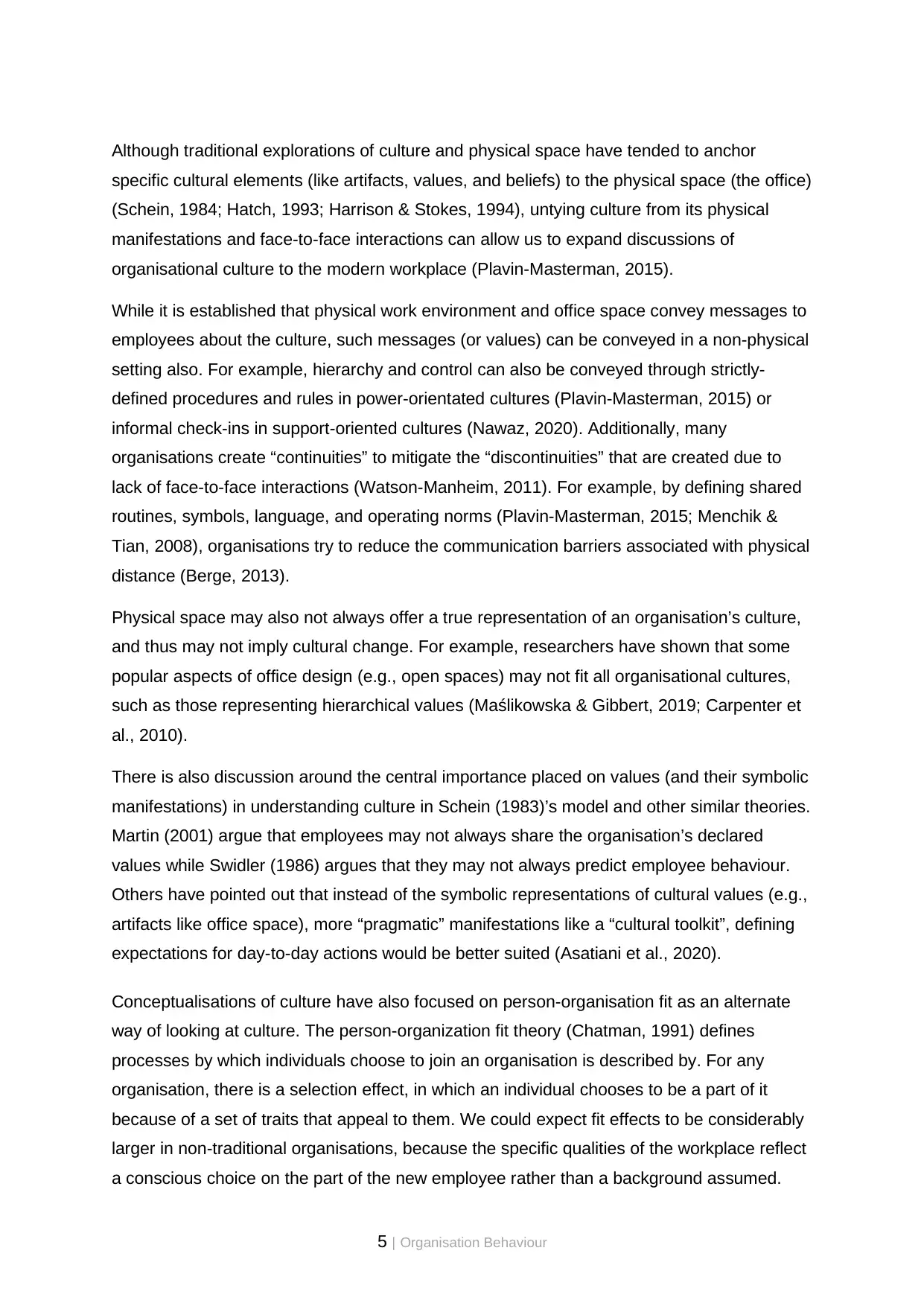
5 | Organisation Behaviour
Although traditional explorations of culture and physical space have tended to anchor
specific cultural elements (like artifacts, values, and beliefs) to the physical space (the office)
(Schein, 1984; Hatch, 1993; Harrison & Stokes, 1994), untying culture from its physical
manifestations and face-to-face interactions can allow us to expand discussions of
organisational culture to the modern workplace (Plavin-Masterman, 2015).
While it is established that physical work environment and office space convey messages to
employees about the culture, such messages (or values) can be conveyed in a non-physical
setting also. For example, hierarchy and control can also be conveyed through strictly-
defined procedures and rules in power-orientated cultures (Plavin-Masterman, 2015) or
informal check-ins in support-oriented cultures (Nawaz, 2020). Additionally, many
organisations create “continuities” to mitigate the “discontinuities” that are created due to
lack of face-to-face interactions (Watson-Manheim, 2011). For example, by defining shared
routines, symbols, language, and operating norms (Plavin-Masterman, 2015; Menchik &
Tian, 2008), organisations try to reduce the communication barriers associated with physical
distance (Berge, 2013).
Physical space may also not always offer a true representation of an organisation’s culture,
and thus may not imply cultural change. For example, researchers have shown that some
popular aspects of office design (e.g., open spaces) may not fit all organisational cultures,
such as those representing hierarchical values (Maślikowska & Gibbert, 2019; Carpenter et
al., 2010).
There is also discussion around the central importance placed on values (and their symbolic
manifestations) in understanding culture in Schein (1983)’s model and other similar theories.
Martin (2001) argue that employees may not always share the organisation’s declared
values while Swidler (1986) argues that they may not always predict employee behaviour.
Others have pointed out that instead of the symbolic representations of cultural values (e.g.,
artifacts like office space), more “pragmatic” manifestations like a “cultural toolkit”, defining
expectations for day-to-day actions would be better suited (Asatiani et al., 2020).
Conceptualisations of culture have also focused on person-organisation fit as an alternate
way of looking at culture. The person-organization fit theory (Chatman, 1991) defines
processes by which individuals choose to join an organisation is described by. For any
organisation, there is a selection effect, in which an individual chooses to be a part of it
because of a set of traits that appeal to them. We could expect fit effects to be considerably
larger in non-traditional organisations, because the specific qualities of the workplace reflect
a conscious choice on the part of the new employee rather than a background assumed.
Although traditional explorations of culture and physical space have tended to anchor
specific cultural elements (like artifacts, values, and beliefs) to the physical space (the office)
(Schein, 1984; Hatch, 1993; Harrison & Stokes, 1994), untying culture from its physical
manifestations and face-to-face interactions can allow us to expand discussions of
organisational culture to the modern workplace (Plavin-Masterman, 2015).
While it is established that physical work environment and office space convey messages to
employees about the culture, such messages (or values) can be conveyed in a non-physical
setting also. For example, hierarchy and control can also be conveyed through strictly-
defined procedures and rules in power-orientated cultures (Plavin-Masterman, 2015) or
informal check-ins in support-oriented cultures (Nawaz, 2020). Additionally, many
organisations create “continuities” to mitigate the “discontinuities” that are created due to
lack of face-to-face interactions (Watson-Manheim, 2011). For example, by defining shared
routines, symbols, language, and operating norms (Plavin-Masterman, 2015; Menchik &
Tian, 2008), organisations try to reduce the communication barriers associated with physical
distance (Berge, 2013).
Physical space may also not always offer a true representation of an organisation’s culture,
and thus may not imply cultural change. For example, researchers have shown that some
popular aspects of office design (e.g., open spaces) may not fit all organisational cultures,
such as those representing hierarchical values (Maślikowska & Gibbert, 2019; Carpenter et
al., 2010).
There is also discussion around the central importance placed on values (and their symbolic
manifestations) in understanding culture in Schein (1983)’s model and other similar theories.
Martin (2001) argue that employees may not always share the organisation’s declared
values while Swidler (1986) argues that they may not always predict employee behaviour.
Others have pointed out that instead of the symbolic representations of cultural values (e.g.,
artifacts like office space), more “pragmatic” manifestations like a “cultural toolkit”, defining
expectations for day-to-day actions would be better suited (Asatiani et al., 2020).
Conceptualisations of culture have also focused on person-organisation fit as an alternate
way of looking at culture. The person-organization fit theory (Chatman, 1991) defines
processes by which individuals choose to join an organisation is described by. For any
organisation, there is a selection effect, in which an individual chooses to be a part of it
because of a set of traits that appeal to them. We could expect fit effects to be considerably
larger in non-traditional organisations, because the specific qualities of the workplace reflect
a conscious choice on the part of the new employee rather than a background assumed.
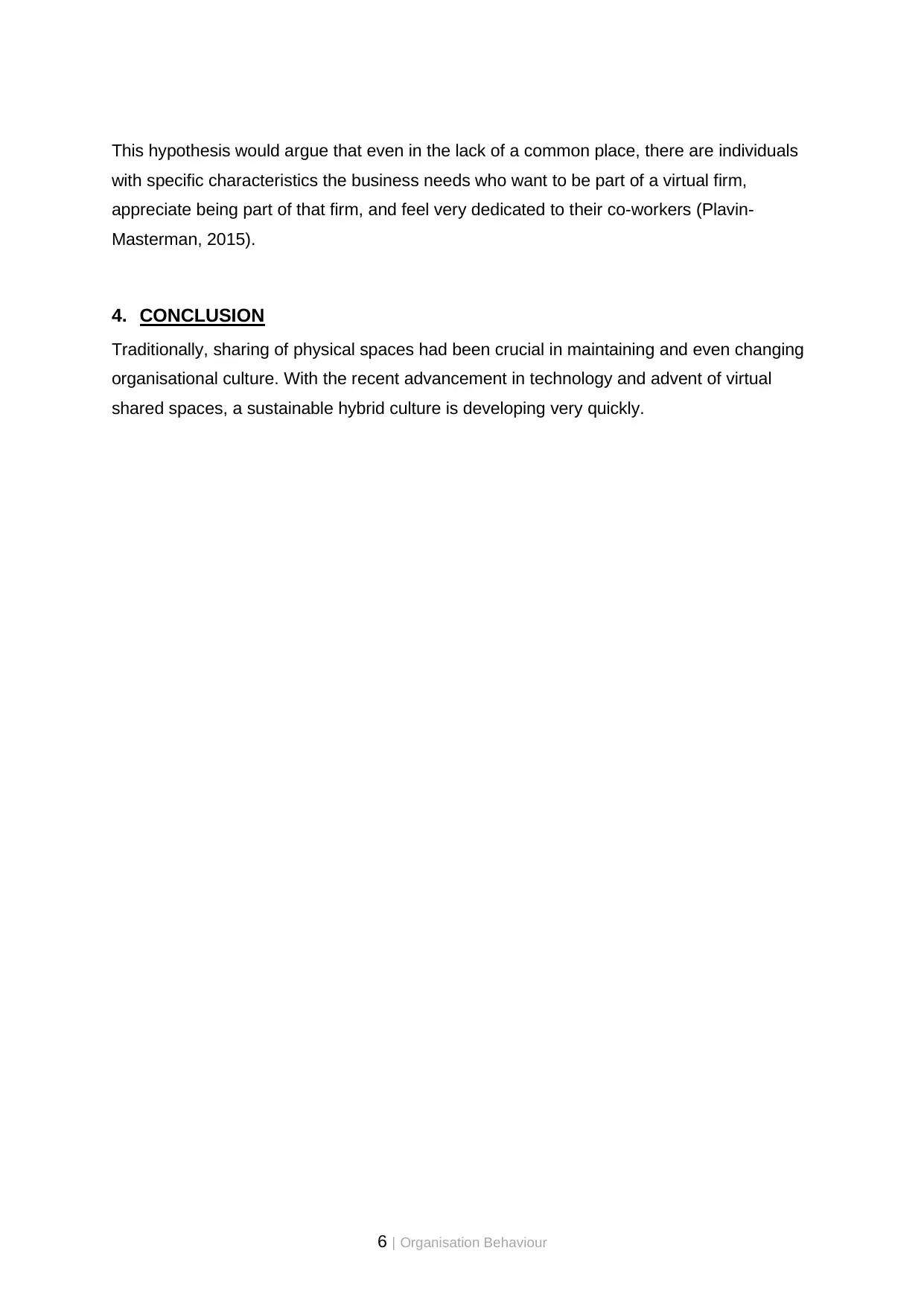
6 | Organisation Behaviour
This hypothesis would argue that even in the lack of a common place, there are individuals
with specific characteristics the business needs who want to be part of a virtual firm,
appreciate being part of that firm, and feel very dedicated to their co-workers (Plavin-
Masterman, 2015).
4. CONCLUSION
Traditionally, sharing of physical spaces had been crucial in maintaining and even changing
organisational culture. With the recent advancement in technology and advent of virtual
shared spaces, a sustainable hybrid culture is developing very quickly.
This hypothesis would argue that even in the lack of a common place, there are individuals
with specific characteristics the business needs who want to be part of a virtual firm,
appreciate being part of that firm, and feel very dedicated to their co-workers (Plavin-
Masterman, 2015).
4. CONCLUSION
Traditionally, sharing of physical spaces had been crucial in maintaining and even changing
organisational culture. With the recent advancement in technology and advent of virtual
shared spaces, a sustainable hybrid culture is developing very quickly.
⊘ This is a preview!⊘
Do you want full access?
Subscribe today to unlock all pages.

Trusted by 1+ million students worldwide
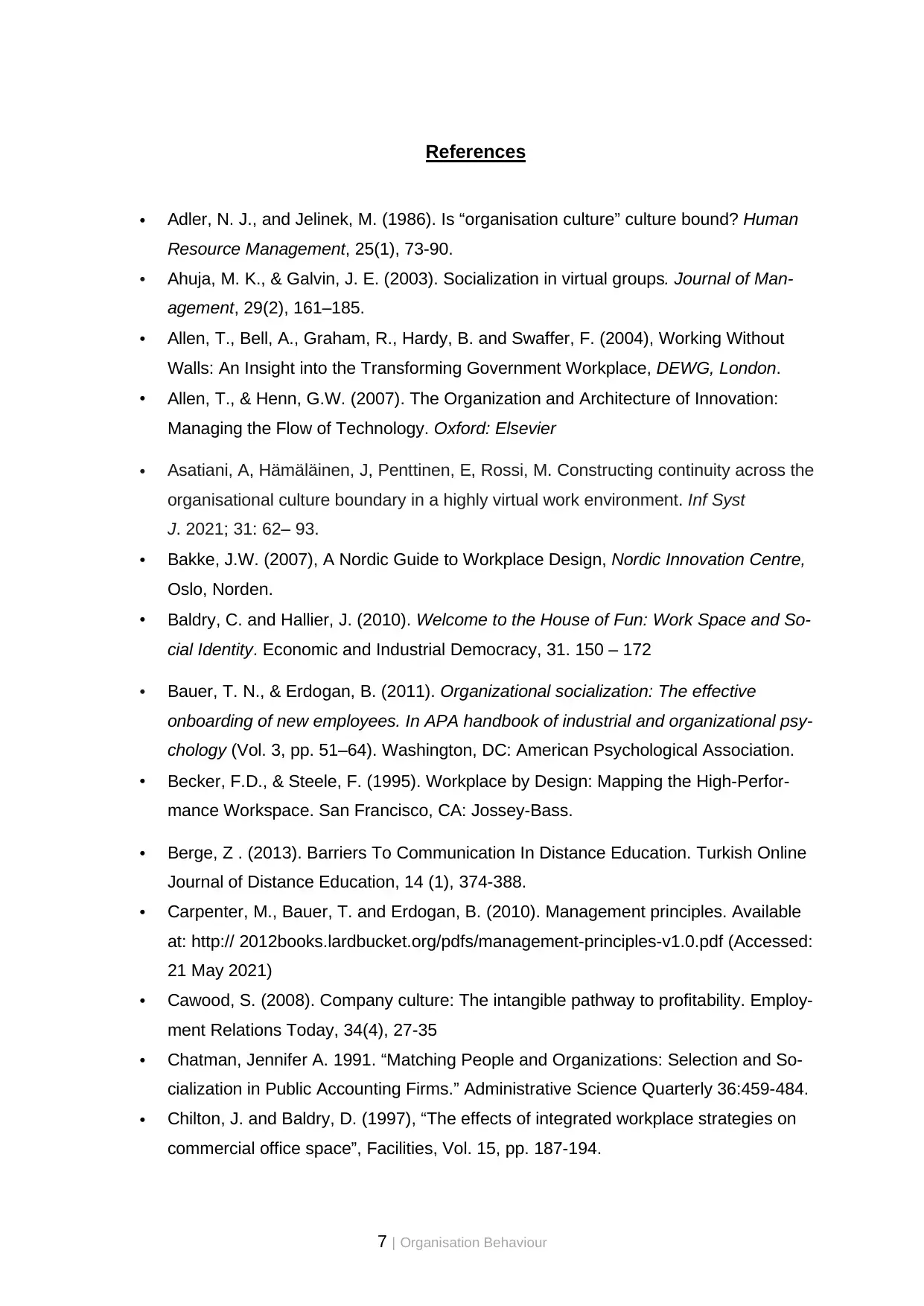
7 | Organisation Behaviour
References
• Adler, N. J., and Jelinek, M. (1986). Is “organisation culture” culture bound? Human
Resource Management, 25(1), 73-90.
• Ahuja, M. K., & Galvin, J. E. (2003). Socialization in virtual groups. Journal of Man-
agement, 29(2), 161–185.
• Allen, T., Bell, A., Graham, R., Hardy, B. and Swaffer, F. (2004), Working Without
Walls: An Insight into the Transforming Government Workplace, DEWG, London.
• Allen, T., & Henn, G.W. (2007). The Organization and Architecture of Innovation:
Managing the Flow of Technology. Oxford: Elsevier
• Asatiani, A, Hämäläinen, J, Penttinen, E, Rossi, M. Constructing continuity across the
organisational culture boundary in a highly virtual work environment. Inf Syst
J. 2021; 31: 62– 93.
• Bakke, J.W. (2007), A Nordic Guide to Workplace Design, Nordic Innovation Centre,
Oslo, Norden.
• Baldry, C. and Hallier, J. (2010). Welcome to the House of Fun: Work Space and So-
cial Identity. Economic and Industrial Democracy, 31. 150 – 172
• Bauer, T. N., & Erdogan, B. (2011). Organizational socialization: The effective
onboarding of new employees. In APA handbook of industrial and organizational psy-
chology (Vol. 3, pp. 51–64). Washington, DC: American Psychological Association.
• Becker, F.D., & Steele, F. (1995). Workplace by Design: Mapping the High-Perfor-
mance Workspace. San Francisco, CA: Jossey-Bass.
• Berge, Z . (2013). Barriers To Communication In Distance Education. Turkish Online
Journal of Distance Education, 14 (1), 374-388.
• Carpenter, M., Bauer, T. and Erdogan, B. (2010). Management principles. Available
at: http:// 2012books.lardbucket.org/pdfs/management-principles-v1.0.pdf (Accessed:
21 May 2021)
• Cawood, S. (2008). Company culture: The intangible pathway to profitability. Employ-
ment Relations Today, 34(4), 27-35
• Chatman, Jennifer A. 1991. “Matching People and Organizations: Selection and So-
cialization in Public Accounting Firms.” Administrative Science Quarterly 36:459-484.
• Chilton, J. and Baldry, D. (1997), “The effects of integrated workplace strategies on
commercial office space”, Facilities, Vol. 15, pp. 187-194.
References
• Adler, N. J., and Jelinek, M. (1986). Is “organisation culture” culture bound? Human
Resource Management, 25(1), 73-90.
• Ahuja, M. K., & Galvin, J. E. (2003). Socialization in virtual groups. Journal of Man-
agement, 29(2), 161–185.
• Allen, T., Bell, A., Graham, R., Hardy, B. and Swaffer, F. (2004), Working Without
Walls: An Insight into the Transforming Government Workplace, DEWG, London.
• Allen, T., & Henn, G.W. (2007). The Organization and Architecture of Innovation:
Managing the Flow of Technology. Oxford: Elsevier
• Asatiani, A, Hämäläinen, J, Penttinen, E, Rossi, M. Constructing continuity across the
organisational culture boundary in a highly virtual work environment. Inf Syst
J. 2021; 31: 62– 93.
• Bakke, J.W. (2007), A Nordic Guide to Workplace Design, Nordic Innovation Centre,
Oslo, Norden.
• Baldry, C. and Hallier, J. (2010). Welcome to the House of Fun: Work Space and So-
cial Identity. Economic and Industrial Democracy, 31. 150 – 172
• Bauer, T. N., & Erdogan, B. (2011). Organizational socialization: The effective
onboarding of new employees. In APA handbook of industrial and organizational psy-
chology (Vol. 3, pp. 51–64). Washington, DC: American Psychological Association.
• Becker, F.D., & Steele, F. (1995). Workplace by Design: Mapping the High-Perfor-
mance Workspace. San Francisco, CA: Jossey-Bass.
• Berge, Z . (2013). Barriers To Communication In Distance Education. Turkish Online
Journal of Distance Education, 14 (1), 374-388.
• Carpenter, M., Bauer, T. and Erdogan, B. (2010). Management principles. Available
at: http:// 2012books.lardbucket.org/pdfs/management-principles-v1.0.pdf (Accessed:
21 May 2021)
• Cawood, S. (2008). Company culture: The intangible pathway to profitability. Employ-
ment Relations Today, 34(4), 27-35
• Chatman, Jennifer A. 1991. “Matching People and Organizations: Selection and So-
cialization in Public Accounting Firms.” Administrative Science Quarterly 36:459-484.
• Chilton, J. and Baldry, D. (1997), “The effects of integrated workplace strategies on
commercial office space”, Facilities, Vol. 15, pp. 187-194.
Paraphrase This Document
Need a fresh take? Get an instant paraphrase of this document with our AI Paraphraser
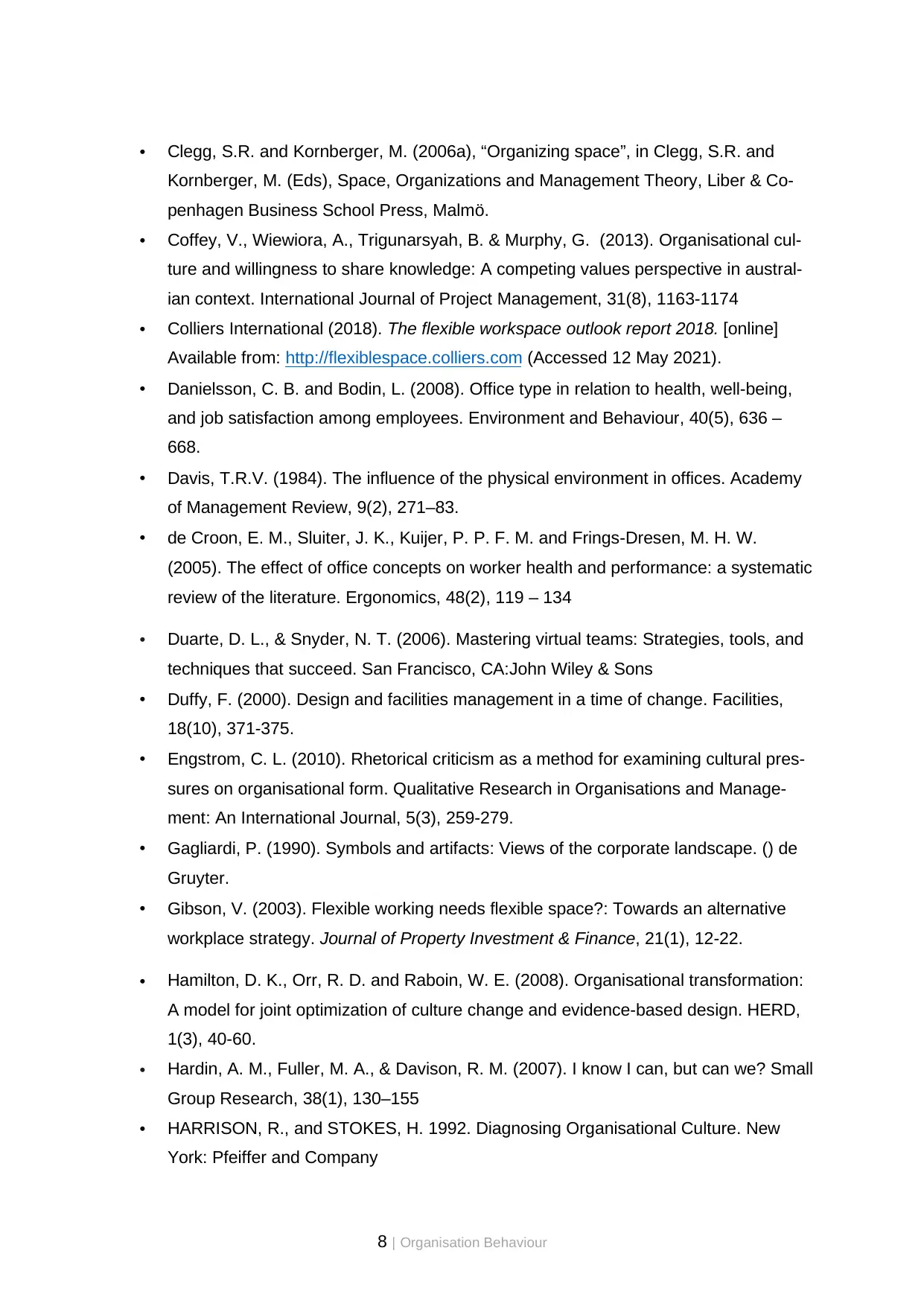
8 | Organisation Behaviour
• Clegg, S.R. and Kornberger, M. (2006a), “Organizing space”, in Clegg, S.R. and
Kornberger, M. (Eds), Space, Organizations and Management Theory, Liber & Co-
penhagen Business School Press, Malmö.
• Coffey, V., Wiewiora, A., Trigunarsyah, B. & Murphy, G. (2013). Organisational cul-
ture and willingness to share knowledge: A competing values perspective in austral-
ian context. International Journal of Project Management, 31(8), 1163-1174
• Colliers International (2018). The flexible workspace outlook report 2018. [online]
Available from: http://flexiblespace.colliers.com (Accessed 12 May 2021).
• Danielsson, C. B. and Bodin, L. (2008). Office type in relation to health, well-being,
and job satisfaction among employees. Environment and Behaviour, 40(5), 636 –
668.
• Davis, T.R.V. (1984). The influence of the physical environment in offices. Academy
of Management Review, 9(2), 271–83.
• de Croon, E. M., Sluiter, J. K., Kuijer, P. P. F. M. and Frings-Dresen, M. H. W.
(2005). The effect of office concepts on worker health and performance: a systematic
review of the literature. Ergonomics, 48(2), 119 – 134
• Duarte, D. L., & Snyder, N. T. (2006). Mastering virtual teams: Strategies, tools, and
techniques that succeed. San Francisco, CA:John Wiley & Sons
• Duffy, F. (2000). Design and facilities management in a time of change. Facilities,
18(10), 371-375.
• Engstrom, C. L. (2010). Rhetorical criticism as a method for examining cultural pres-
sures on organisational form. Qualitative Research in Organisations and Manage-
ment: An International Journal, 5(3), 259-279.
• Gagliardi, P. (1990). Symbols and artifacts: Views of the corporate landscape. () de
Gruyter.
• Gibson, V. (2003). Flexible working needs flexible space?: Towards an alternative
workplace strategy. Journal of Property Investment & Finance, 21(1), 12-22.
• Hamilton, D. K., Orr, R. D. and Raboin, W. E. (2008). Organisational transformation:
A model for joint optimization of culture change and evidence-based design. HERD,
1(3), 40-60.
• Hardin, A. M., Fuller, M. A., & Davison, R. M. (2007). I know I can, but can we? Small
Group Research, 38(1), 130–155
• HARRISON, R., and STOKES, H. 1992. Diagnosing Organisational Culture. New
York: Pfeiffer and Company
• Clegg, S.R. and Kornberger, M. (2006a), “Organizing space”, in Clegg, S.R. and
Kornberger, M. (Eds), Space, Organizations and Management Theory, Liber & Co-
penhagen Business School Press, Malmö.
• Coffey, V., Wiewiora, A., Trigunarsyah, B. & Murphy, G. (2013). Organisational cul-
ture and willingness to share knowledge: A competing values perspective in austral-
ian context. International Journal of Project Management, 31(8), 1163-1174
• Colliers International (2018). The flexible workspace outlook report 2018. [online]
Available from: http://flexiblespace.colliers.com (Accessed 12 May 2021).
• Danielsson, C. B. and Bodin, L. (2008). Office type in relation to health, well-being,
and job satisfaction among employees. Environment and Behaviour, 40(5), 636 –
668.
• Davis, T.R.V. (1984). The influence of the physical environment in offices. Academy
of Management Review, 9(2), 271–83.
• de Croon, E. M., Sluiter, J. K., Kuijer, P. P. F. M. and Frings-Dresen, M. H. W.
(2005). The effect of office concepts on worker health and performance: a systematic
review of the literature. Ergonomics, 48(2), 119 – 134
• Duarte, D. L., & Snyder, N. T. (2006). Mastering virtual teams: Strategies, tools, and
techniques that succeed. San Francisco, CA:John Wiley & Sons
• Duffy, F. (2000). Design and facilities management in a time of change. Facilities,
18(10), 371-375.
• Engstrom, C. L. (2010). Rhetorical criticism as a method for examining cultural pres-
sures on organisational form. Qualitative Research in Organisations and Manage-
ment: An International Journal, 5(3), 259-279.
• Gagliardi, P. (1990). Symbols and artifacts: Views of the corporate landscape. () de
Gruyter.
• Gibson, V. (2003). Flexible working needs flexible space?: Towards an alternative
workplace strategy. Journal of Property Investment & Finance, 21(1), 12-22.
• Hamilton, D. K., Orr, R. D. and Raboin, W. E. (2008). Organisational transformation:
A model for joint optimization of culture change and evidence-based design. HERD,
1(3), 40-60.
• Hardin, A. M., Fuller, M. A., & Davison, R. M. (2007). I know I can, but can we? Small
Group Research, 38(1), 130–155
• HARRISON, R., and STOKES, H. 1992. Diagnosing Organisational Culture. New
York: Pfeiffer and Company
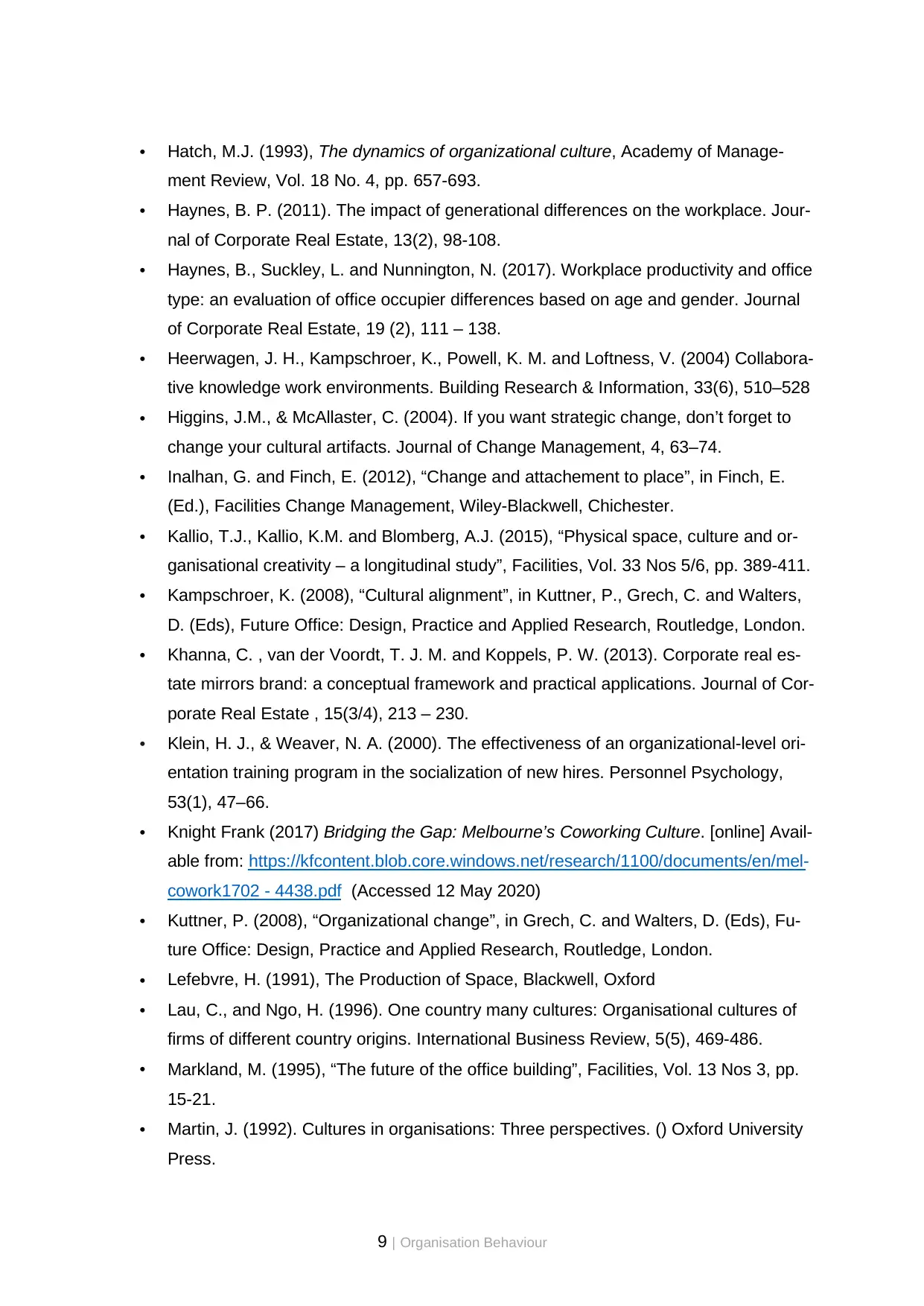
9 | Organisation Behaviour
• Hatch, M.J. (1993), The dynamics of organizational culture, Academy of Manage-
ment Review, Vol. 18 No. 4, pp. 657-693.
• Haynes, B. P. (2011). The impact of generational differences on the workplace. Jour-
nal of Corporate Real Estate, 13(2), 98-108.
• Haynes, B., Suckley, L. and Nunnington, N. (2017). Workplace productivity and office
type: an evaluation of office occupier differences based on age and gender. Journal
of Corporate Real Estate, 19 (2), 111 – 138.
• Heerwagen, J. H., Kampschroer, K., Powell, K. M. and Loftness, V. (2004) Collabora-
tive knowledge work environments. Building Research & Information, 33(6), 510–528
• Higgins, J.M., & McAllaster, C. (2004). If you want strategic change, don’t forget to
change your cultural artifacts. Journal of Change Management, 4, 63–74.
• Inalhan, G. and Finch, E. (2012), “Change and attachement to place”, in Finch, E.
(Ed.), Facilities Change Management, Wiley-Blackwell, Chichester.
• Kallio, T.J., Kallio, K.M. and Blomberg, A.J. (2015), “Physical space, culture and or-
ganisational creativity – a longitudinal study”, Facilities, Vol. 33 Nos 5/6, pp. 389-411.
• Kampschroer, K. (2008), “Cultural alignment”, in Kuttner, P., Grech, C. and Walters,
D. (Eds), Future Office: Design, Practice and Applied Research, Routledge, London.
• Khanna, C. , van der Voordt, T. J. M. and Koppels, P. W. (2013). Corporate real es-
tate mirrors brand: a conceptual framework and practical applications. Journal of Cor-
porate Real Estate , 15(3/4), 213 – 230.
• Klein, H. J., & Weaver, N. A. (2000). The effectiveness of an organizational-level ori-
entation training program in the socialization of new hires. Personnel Psychology,
53(1), 47–66.
• Knight Frank (2017) Bridging the Gap: Melbourne’s Coworking Culture. [online] Avail-
able from: https://kfcontent.blob.core.windows.net/research/1100/documents/en/mel-
cowork1702 - 4438.pdf (Accessed 12 May 2020)
• Kuttner, P. (2008), “Organizational change”, in Grech, C. and Walters, D. (Eds), Fu-
ture Office: Design, Practice and Applied Research, Routledge, London.
• Lefebvre, H. (1991), The Production of Space, Blackwell, Oxford
• Lau, C., and Ngo, H. (1996). One country many cultures: Organisational cultures of
firms of different country origins. International Business Review, 5(5), 469-486.
• Markland, M. (1995), “The future of the office building”, Facilities, Vol. 13 Nos 3, pp.
15-21.
• Martin, J. (1992). Cultures in organisations: Three perspectives. () Oxford University
Press.
• Hatch, M.J. (1993), The dynamics of organizational culture, Academy of Manage-
ment Review, Vol. 18 No. 4, pp. 657-693.
• Haynes, B. P. (2011). The impact of generational differences on the workplace. Jour-
nal of Corporate Real Estate, 13(2), 98-108.
• Haynes, B., Suckley, L. and Nunnington, N. (2017). Workplace productivity and office
type: an evaluation of office occupier differences based on age and gender. Journal
of Corporate Real Estate, 19 (2), 111 – 138.
• Heerwagen, J. H., Kampschroer, K., Powell, K. M. and Loftness, V. (2004) Collabora-
tive knowledge work environments. Building Research & Information, 33(6), 510–528
• Higgins, J.M., & McAllaster, C. (2004). If you want strategic change, don’t forget to
change your cultural artifacts. Journal of Change Management, 4, 63–74.
• Inalhan, G. and Finch, E. (2012), “Change and attachement to place”, in Finch, E.
(Ed.), Facilities Change Management, Wiley-Blackwell, Chichester.
• Kallio, T.J., Kallio, K.M. and Blomberg, A.J. (2015), “Physical space, culture and or-
ganisational creativity – a longitudinal study”, Facilities, Vol. 33 Nos 5/6, pp. 389-411.
• Kampschroer, K. (2008), “Cultural alignment”, in Kuttner, P., Grech, C. and Walters,
D. (Eds), Future Office: Design, Practice and Applied Research, Routledge, London.
• Khanna, C. , van der Voordt, T. J. M. and Koppels, P. W. (2013). Corporate real es-
tate mirrors brand: a conceptual framework and practical applications. Journal of Cor-
porate Real Estate , 15(3/4), 213 – 230.
• Klein, H. J., & Weaver, N. A. (2000). The effectiveness of an organizational-level ori-
entation training program in the socialization of new hires. Personnel Psychology,
53(1), 47–66.
• Knight Frank (2017) Bridging the Gap: Melbourne’s Coworking Culture. [online] Avail-
able from: https://kfcontent.blob.core.windows.net/research/1100/documents/en/mel-
cowork1702 - 4438.pdf (Accessed 12 May 2020)
• Kuttner, P. (2008), “Organizational change”, in Grech, C. and Walters, D. (Eds), Fu-
ture Office: Design, Practice and Applied Research, Routledge, London.
• Lefebvre, H. (1991), The Production of Space, Blackwell, Oxford
• Lau, C., and Ngo, H. (1996). One country many cultures: Organisational cultures of
firms of different country origins. International Business Review, 5(5), 469-486.
• Markland, M. (1995), “The future of the office building”, Facilities, Vol. 13 Nos 3, pp.
15-21.
• Martin, J. (1992). Cultures in organisations: Three perspectives. () Oxford University
Press.
⊘ This is a preview!⊘
Do you want full access?
Subscribe today to unlock all pages.

Trusted by 1+ million students worldwide
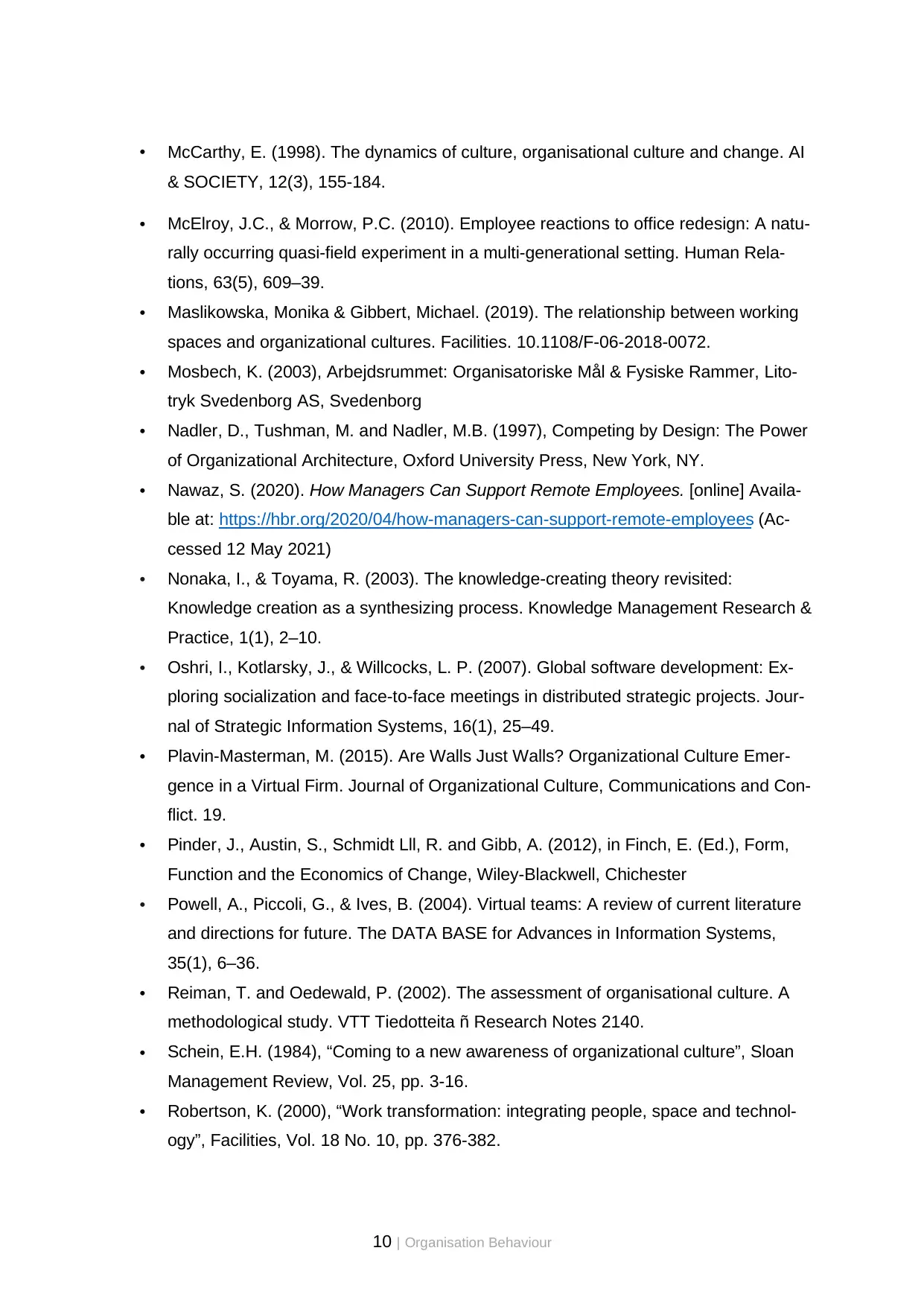
10 | Organisation Behaviour
• McCarthy, E. (1998). The dynamics of culture, organisational culture and change. AI
& SOCIETY, 12(3), 155-184.
• McElroy, J.C., & Morrow, P.C. (2010). Employee reactions to office redesign: A natu-
rally occurring quasi-field experiment in a multi-generational setting. Human Rela-
tions, 63(5), 609–39.
• Maslikowska, Monika & Gibbert, Michael. (2019). The relationship between working
spaces and organizational cultures. Facilities. 10.1108/F-06-2018-0072.
• Mosbech, K. (2003), Arbejdsrummet: Organisatoriske Mål & Fysiske Rammer, Lito-
tryk Svedenborg AS, Svedenborg
• Nadler, D., Tushman, M. and Nadler, M.B. (1997), Competing by Design: The Power
of Organizational Architecture, Oxford University Press, New York, NY.
• Nawaz, S. (2020). How Managers Can Support Remote Employees. [online] Availa-
ble at: https://hbr.org/2020/04/how-managers-can-support-remote-employees (Ac-
cessed 12 May 2021)
• Nonaka, I., & Toyama, R. (2003). The knowledge-creating theory revisited:
Knowledge creation as a synthesizing process. Knowledge Management Research &
Practice, 1(1), 2–10.
• Oshri, I., Kotlarsky, J., & Willcocks, L. P. (2007). Global software development: Ex-
ploring socialization and face-to-face meetings in distributed strategic projects. Jour-
nal of Strategic Information Systems, 16(1), 25–49.
• Plavin-Masterman, M. (2015). Are Walls Just Walls? Organizational Culture Emer-
gence in a Virtual Firm. Journal of Organizational Culture, Communications and Con-
flict. 19.
• Pinder, J., Austin, S., Schmidt Lll, R. and Gibb, A. (2012), in Finch, E. (Ed.), Form,
Function and the Economics of Change, Wiley-Blackwell, Chichester
• Powell, A., Piccoli, G., & Ives, B. (2004). Virtual teams: A review of current literature
and directions for future. The DATA BASE for Advances in Information Systems,
35(1), 6–36.
• Reiman, T. and Oedewald, P. (2002). The assessment of organisational culture. A
methodological study. VTT Tiedotteita ñ Research Notes 2140.
• Schein, E.H. (1984), “Coming to a new awareness of organizational culture”, Sloan
Management Review, Vol. 25, pp. 3-16.
• Robertson, K. (2000), “Work transformation: integrating people, space and technol-
ogy”, Facilities, Vol. 18 No. 10, pp. 376-382.
• McCarthy, E. (1998). The dynamics of culture, organisational culture and change. AI
& SOCIETY, 12(3), 155-184.
• McElroy, J.C., & Morrow, P.C. (2010). Employee reactions to office redesign: A natu-
rally occurring quasi-field experiment in a multi-generational setting. Human Rela-
tions, 63(5), 609–39.
• Maslikowska, Monika & Gibbert, Michael. (2019). The relationship between working
spaces and organizational cultures. Facilities. 10.1108/F-06-2018-0072.
• Mosbech, K. (2003), Arbejdsrummet: Organisatoriske Mål & Fysiske Rammer, Lito-
tryk Svedenborg AS, Svedenborg
• Nadler, D., Tushman, M. and Nadler, M.B. (1997), Competing by Design: The Power
of Organizational Architecture, Oxford University Press, New York, NY.
• Nawaz, S. (2020). How Managers Can Support Remote Employees. [online] Availa-
ble at: https://hbr.org/2020/04/how-managers-can-support-remote-employees (Ac-
cessed 12 May 2021)
• Nonaka, I., & Toyama, R. (2003). The knowledge-creating theory revisited:
Knowledge creation as a synthesizing process. Knowledge Management Research &
Practice, 1(1), 2–10.
• Oshri, I., Kotlarsky, J., & Willcocks, L. P. (2007). Global software development: Ex-
ploring socialization and face-to-face meetings in distributed strategic projects. Jour-
nal of Strategic Information Systems, 16(1), 25–49.
• Plavin-Masterman, M. (2015). Are Walls Just Walls? Organizational Culture Emer-
gence in a Virtual Firm. Journal of Organizational Culture, Communications and Con-
flict. 19.
• Pinder, J., Austin, S., Schmidt Lll, R. and Gibb, A. (2012), in Finch, E. (Ed.), Form,
Function and the Economics of Change, Wiley-Blackwell, Chichester
• Powell, A., Piccoli, G., & Ives, B. (2004). Virtual teams: A review of current literature
and directions for future. The DATA BASE for Advances in Information Systems,
35(1), 6–36.
• Reiman, T. and Oedewald, P. (2002). The assessment of organisational culture. A
methodological study. VTT Tiedotteita ñ Research Notes 2140.
• Schein, E.H. (1984), “Coming to a new awareness of organizational culture”, Sloan
Management Review, Vol. 25, pp. 3-16.
• Robertson, K. (2000), “Work transformation: integrating people, space and technol-
ogy”, Facilities, Vol. 18 No. 10, pp. 376-382.
Paraphrase This Document
Need a fresh take? Get an instant paraphrase of this document with our AI Paraphraser
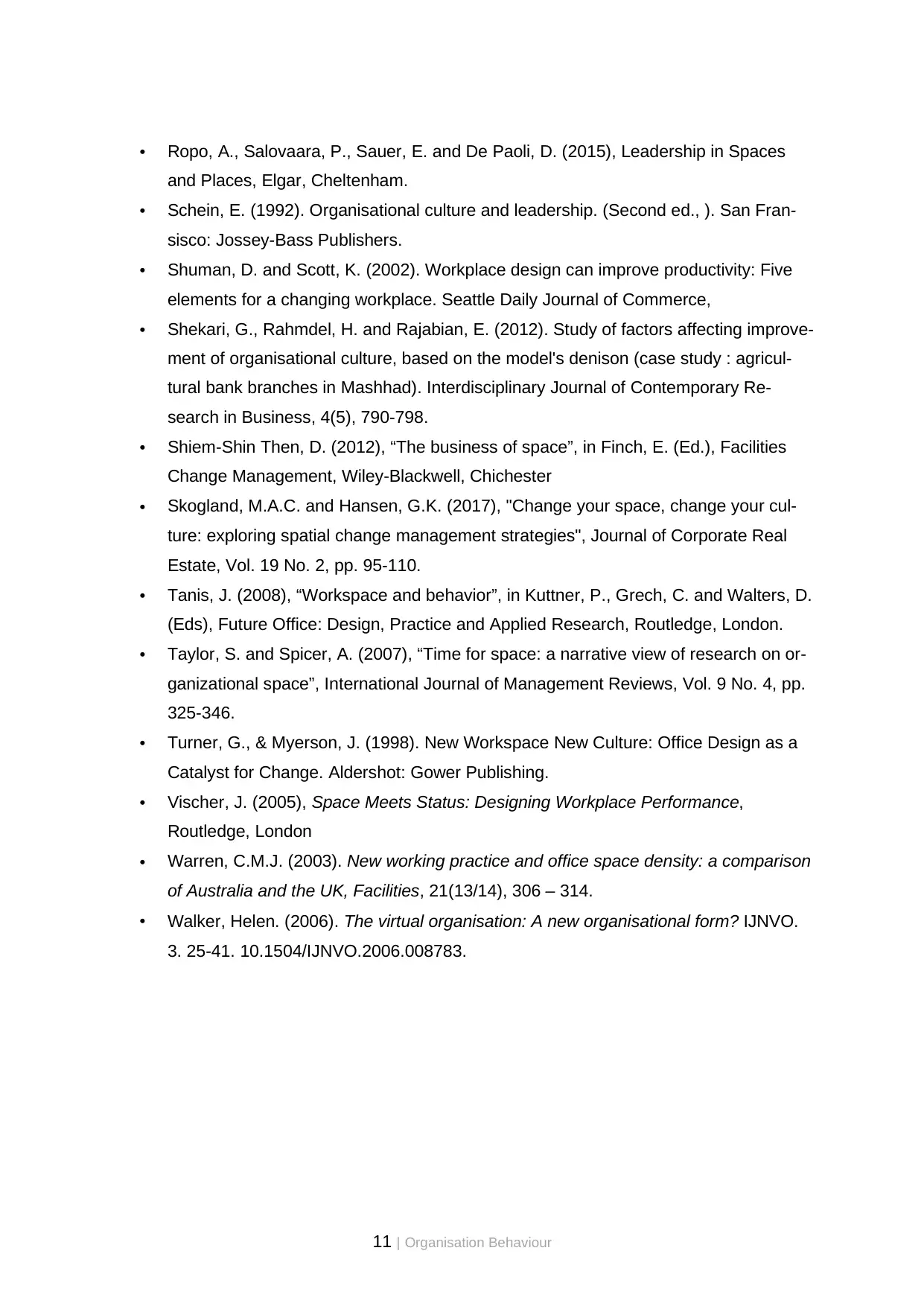
11 | Organisation Behaviour
• Ropo, A., Salovaara, P., Sauer, E. and De Paoli, D. (2015), Leadership in Spaces
and Places, Elgar, Cheltenham.
• Schein, E. (1992). Organisational culture and leadership. (Second ed., ). San Fran-
sisco: Jossey-Bass Publishers.
• Shuman, D. and Scott, K. (2002). Workplace design can improve productivity: Five
elements for a changing workplace. Seattle Daily Journal of Commerce,
• Shekari, G., Rahmdel, H. and Rajabian, E. (2012). Study of factors affecting improve-
ment of organisational culture, based on the model's denison (case study : agricul-
tural bank branches in Mashhad). Interdisciplinary Journal of Contemporary Re-
search in Business, 4(5), 790-798.
• Shiem-Shin Then, D. (2012), “The business of space”, in Finch, E. (Ed.), Facilities
Change Management, Wiley-Blackwell, Chichester
• Skogland, M.A.C. and Hansen, G.K. (2017), "Change your space, change your cul-
ture: exploring spatial change management strategies", Journal of Corporate Real
Estate, Vol. 19 No. 2, pp. 95-110.
• Tanis, J. (2008), “Workspace and behavior”, in Kuttner, P., Grech, C. and Walters, D.
(Eds), Future Office: Design, Practice and Applied Research, Routledge, London.
• Taylor, S. and Spicer, A. (2007), “Time for space: a narrative view of research on or-
ganizational space”, International Journal of Management Reviews, Vol. 9 No. 4, pp.
325-346.
• Turner, G., & Myerson, J. (1998). New Workspace New Culture: Office Design as a
Catalyst for Change. Aldershot: Gower Publishing.
• Vischer, J. (2005), Space Meets Status: Designing Workplace Performance,
Routledge, London
• Warren, C.M.J. (2003). New working practice and office space density: a comparison
of Australia and the UK, Facilities, 21(13/14), 306 – 314.
• Walker, Helen. (2006). The virtual organisation: A new organisational form? IJNVO.
3. 25-41. 10.1504/IJNVO.2006.008783.
• Ropo, A., Salovaara, P., Sauer, E. and De Paoli, D. (2015), Leadership in Spaces
and Places, Elgar, Cheltenham.
• Schein, E. (1992). Organisational culture and leadership. (Second ed., ). San Fran-
sisco: Jossey-Bass Publishers.
• Shuman, D. and Scott, K. (2002). Workplace design can improve productivity: Five
elements for a changing workplace. Seattle Daily Journal of Commerce,
• Shekari, G., Rahmdel, H. and Rajabian, E. (2012). Study of factors affecting improve-
ment of organisational culture, based on the model's denison (case study : agricul-
tural bank branches in Mashhad). Interdisciplinary Journal of Contemporary Re-
search in Business, 4(5), 790-798.
• Shiem-Shin Then, D. (2012), “The business of space”, in Finch, E. (Ed.), Facilities
Change Management, Wiley-Blackwell, Chichester
• Skogland, M.A.C. and Hansen, G.K. (2017), "Change your space, change your cul-
ture: exploring spatial change management strategies", Journal of Corporate Real
Estate, Vol. 19 No. 2, pp. 95-110.
• Tanis, J. (2008), “Workspace and behavior”, in Kuttner, P., Grech, C. and Walters, D.
(Eds), Future Office: Design, Practice and Applied Research, Routledge, London.
• Taylor, S. and Spicer, A. (2007), “Time for space: a narrative view of research on or-
ganizational space”, International Journal of Management Reviews, Vol. 9 No. 4, pp.
325-346.
• Turner, G., & Myerson, J. (1998). New Workspace New Culture: Office Design as a
Catalyst for Change. Aldershot: Gower Publishing.
• Vischer, J. (2005), Space Meets Status: Designing Workplace Performance,
Routledge, London
• Warren, C.M.J. (2003). New working practice and office space density: a comparison
of Australia and the UK, Facilities, 21(13/14), 306 – 314.
• Walker, Helen. (2006). The virtual organisation: A new organisational form? IJNVO.
3. 25-41. 10.1504/IJNVO.2006.008783.
1 out of 11
Your All-in-One AI-Powered Toolkit for Academic Success.
+13062052269
info@desklib.com
Available 24*7 on WhatsApp / Email
![[object Object]](/_next/static/media/star-bottom.7253800d.svg)
Unlock your academic potential
Copyright © 2020–2025 A2Z Services. All Rights Reserved. Developed and managed by ZUCOL.
